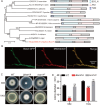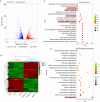The mitochondrial protein Bcs1A regulates antifungal drug tolerance by affecting efflux pump expression in the filamentous pathogenic fungus Aspergillus fumigatus
- PMID: 39162512
- PMCID: PMC11448404
- DOI: 10.1128/spectrum.01172-24
The mitochondrial protein Bcs1A regulates antifungal drug tolerance by affecting efflux pump expression in the filamentous pathogenic fungus Aspergillus fumigatus
Abstract
Aspergillus fumigatus is the predominant pathogen responsible for aspergillosis infections, with emerging drug-resistant strains complicating treatment strategies. The role of mitochondrial functionality in fungal resistance to antifungal agents is well-documented yet not fully understood. In this study, the mitochondrial protein Bcs1A, a homolog of yeast Bcs1, was found to regulate colony growth, ion homeostasis, and the response to antifungal drugs in A. fumigatus. Microscopic observations revealed substantial colocalization of Bcs1A-GFP fusion protein fluorescence with mitochondria. Bcs1A deletion compromised colony growth and the utilization of non-fermentable carbon sources, alongside causing abnormal mitochondrial membrane potential and reduced reactive oxygen species production. These findings underscore Bcs1A's vital role in maintaining mitochondrial integrity. Phenotypic analysis and determinations of minimum inhibitory concentrations indicated that the Δbcs1A mutant was more resistant to various antifungal agents, such as azoles, terbinafine, and simvastatin, compared to wild-type strain. RNA sequencing and RT-qPCR analysis highlighted an upregulation of multiple efflux pumps in the Δbcs1A mutant. Furthermore, loss of the principal drug efflux pump, mdr1, decreased azole tolerance in the Δbcs1A mutant, suggesting that Bcs1A's modulated of azoles response via efflux pump expression. Collectively, these results establish Bcs1A as essential for growth and antifungal drug responsiveness in A. fumigatus mediated through mitochondrial regulation.IMPORTANCEDrug resistance presents a formidable obstacle in the clinical management of aspergillosis. Mitochondria are integral to various biochemical pathways, including those involved in fungi drug response, making mitochondrial proteins promising therapeutic targets for drug therapy. This study confirms that Bcs1A, a mitochondrial respiratory chain protein, is indispensable for mitochondrial functionality and multidrug tolerance in Aspergillus fumigatus. Mutation of Bcs1A not only leads to a series of drug efflux pumps upregulated but also shows that loss of the primary efflux pump, mdr1, partial reduction in drug tolerance in the Bcs1A mutant, highlighting that Bcs1A's significant influence on mitochondria-mediated drug resistance.
Keywords: Aspergillus fumigatus; Bcs1A; drug resistance; mitochondria; vegetative growth.
Conflict of interest statement
The authors declare no conflict of interest.
Figures






Similar articles
-
Aspergillus fumigatus Transcription Factors Involved in the Caspofungin Paradoxical Effect.mBio. 2020 Jun 16;11(3):e00816-20. doi: 10.1128/mBio.00816-20. mBio. 2020. PMID: 32546620 Free PMC article.
-
Azole resistance in Aspergillus fumigatus- comprehensive review.Arch Microbiol. 2024 Jun 15;206(7):305. doi: 10.1007/s00203-024-04026-z. Arch Microbiol. 2024. PMID: 38878211 Review.
-
A Novel Zn2-Cys6 Transcription Factor AtrR Plays a Key Role in an Azole Resistance Mechanism of Aspergillus fumigatus by Co-regulating cyp51A and cdr1B Expressions.PLoS Pathog. 2017 Jan 4;13(1):e1006096. doi: 10.1371/journal.ppat.1006096. eCollection 2017 Jan. PLoS Pathog. 2017. PMID: 28052140 Free PMC article.
-
Azole resistance of Aspergillus fumigatus biofilms is partly associated with efflux pump activity.Antimicrob Agents Chemother. 2011 May;55(5):2092-7. doi: 10.1128/AAC.01189-10. Epub 2011 Feb 14. Antimicrob Agents Chemother. 2011. PMID: 21321135 Free PMC article.
-
The molecular mechanism of azole resistance in Aspergillus fumigatus: from bedside to bench and back.J Microbiol. 2015 Feb;53(2):91-9. doi: 10.1007/s12275-015-5014-7. Epub 2015 Jan 28. J Microbiol. 2015. PMID: 25626363 Review.
Cited by
-
The phenomenon of anhydrobiosis-structural and functional changes in yeast cells.Appl Microbiol Biotechnol. 2025 Jun 25;109(1):152. doi: 10.1007/s00253-025-13539-6. Appl Microbiol Biotechnol. 2025. PMID: 40560253 Free PMC article. Review.
-
Aspergillus fumigatus mitogenomes and their influence on azole-resistant and -susceptible populations.NPJ Antimicrob Resist. 2025 Feb 27;3(1):15. doi: 10.1038/s44259-025-00083-6. NPJ Antimicrob Resist. 2025. PMID: 40016509 Free PMC article.
References
-
- de Castro PA, Colabardini AC, Manfiolli AO, Chiaratto J, Silva LP, Mattos EC, Palmisano G, Almeida F, Persinoti GF, Ries LNA, Mellado L, Rocha MC, Bromley M, Silva RN, de Souza GS, Loures FV, Malavazi I, Brown NA, Goldman GH. 2019. Aspergillus fumigatus calcium-responsive transcription factors regulate cell wall architecture promoting stress tolerance, virulence and caspofungin resistance. PLoS Genet 15:e1008551. doi:10.1371/journal.pgen.1008551 - DOI - PMC - PubMed
-
- Abad A, Fernández-Molina JV, Bikandi J, Ramírez A, Margareto J, Sendino J, Hernando FL, Pontón J, Garaizar J, Rementeria A. 2010. What makes Aspergillus fumigatus a successful pathogen? Genes and molecules involved in invasive aspergillosis. Rev Iberoam Micol 27:155–182. doi:10.1016/j.riam.2010.10.003 - DOI - PubMed
MeSH terms
Substances
Grants and funding
- 32100152/the National Natural Science Foundation of China
- 2108085QC90/the Natural Science Foundation of Anhui Province
- KJ2021A0775/the Scientific Research Foundation of Higher Education Institutions of Anhui Province
- Byycxz23011/the Graduate Research and Innovation Projects of Bengbu Medical University
- S202110367007,S202310367042/the Undergraduate Research and Innovation Project of Anhui Province
LinkOut - more resources
Full Text Sources

